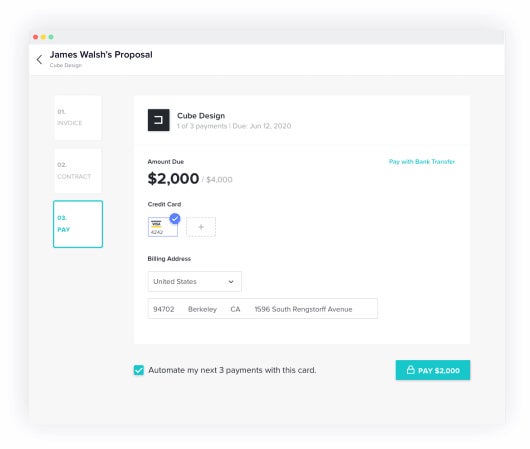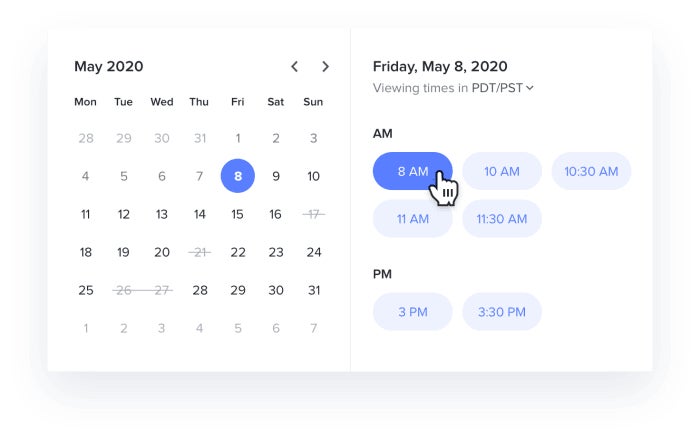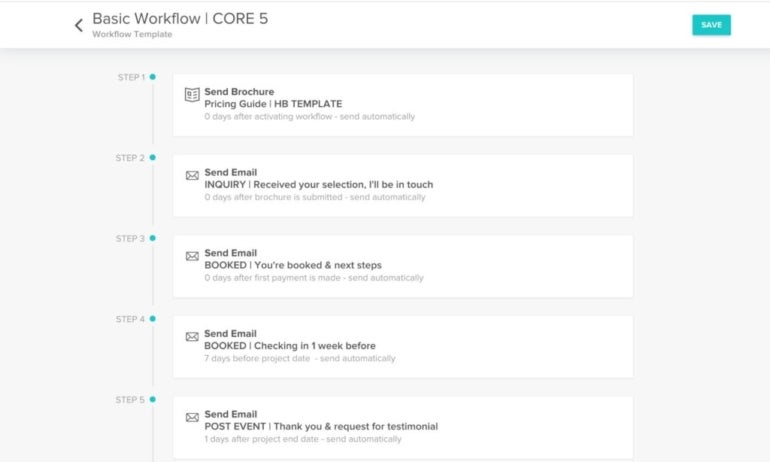HoneyBook bills itself as a clientflow management platform for independent businesses. It aims to combine multiple functions — including invoices, online payments, scheduling and CRM software — into one single platform.
In this review, we dive deep into the pros and cons of HoneyBook to help you decide if it’s the right choice for your small business.
Jump to:
- HoneyBook’s pricing
- HoneyBook’s key features
- HoneyBook pros
- HoneyBook cons
- HoneyBook integrations
- Who is HoneyBook best for?
- Alternatives to HoneyBook
- Review methodology
HoneyBook’s pricing
HoneyBook offers three different pricing plans. A seven-day free trial is available for all three plans, and they each come with a 60-day money back guarantee as well.
Starter
The Starter plan starts at $8 per month billed yearly for the first year or $1 billed monthly for the first two months. After the promotional period, the plan costs $16 per month billed annually or $19 per month billed monthly. The Starter plan includes unlimited clients and projects, invoices, payments, proposals, contracts and a client portal.
Essentials
The Essentials plan starts at $16 per month billed yearly for the first year or $1 billed monthly for the first two months. After the promotional period, the plan costs $32 per month billed annually or $39 per month billed monthly. The Essentials plan includes automations, a QuickBooks Online integration, up to two team members and expense management.
Premium
The Premium plan starts at $33 per month billed yearly for the first year or $1 billed monthly for the first two months. After the promotional period, the plan costs $66 per month billed annually or $79 per month billed monthly. The Premium plan includes unlimited team members, multiple companies, priority support, an onboarding specialist and a dedicated account manager.
HoneyBook’s key features
Invoices, proposals and contracts
Figure A

HoneyBook makes it simple to create an invoice (Figure A), customize it with your brand and send a link right to a customer. The software will walk new users through the entire process with friendly pop-ups, though the system is well laid-out and easy to figure out on your own.
If you have an intermediate proposal stage instead of jumping straight into invoices, you can choose from a few contract templates, fill in your information and send it to your client for eSigning.
Online payments
Figure B

Once you’ve created your invoice, your clients can pay you directly through HoneyBook (Figure B). HoneyBook accepts major debit and credit cards as well as bank transfers, but it does not integrate with external payment gateways such as PayPal, Square and Stripe. Clients can also choose to set up auto-pay if they wish, and HoneyBook will automatically send payment reminders to those who don’t.
Processing fees are as low as 2.9% + 25¢ for card payments or 1.5% for ACH payments. HoneyBook also offers the option of Instant Deposit to get your funds immediately instead of in 2-3 business days.
Scheduling
Figure C

HoneyBook is known for its seamless scheduling tool (Figure C), which is available for the Essentials and Premium plans. Simply set your availability and share the link with potential clients so they can book meetings with you directly at a time that works for them.
You can even build in time buffers and set up different types of sessions so you don’t overbook yourself. New sessions will automatically be added to your calendar and the clients’, and automated reminders will keep your clients on track.
CRM
Figure D

HoneyBook also offers simple customer relationship management (CRM) tools for freelancers and small businesses. Once you create a contact, all of your messages and payments will be logged on their contact page. You can also add clients to different projects and give them access to a shared workspace using the client portal option. New leads and communications will show up on the HoneyBook dashboard (Figure D).
Automations and AI
Figure E

If you have the Essentials or Premium plan, you also get access to HoneyBook’s automations. These automations can be customized to your workflows and cut down on certain repetitive, manual tasks (Figure E).
For instance, you can use automations to send a questionnaire to a new client or get a reminder when you have a task due. HoneyBook’s AI function will automatically pull branding from your website into the platform and help you compose professional emails.
HoneyBook pros
- Combines many different functions into one easy-to-use platform.
- Guided setup process for new users.
- Friendly tone and approachable visual design.
- Intuitive for clients to use.
- Chat and email support available seven days a week for all plans.
- Secure online payments.
HoneyBook cons
- Limited integrations.
- Must upgrade to the Essentials plan for scheduling, automations and the QuickBooks integration.
- Costs more than some competitors.
- Not ideal for larger companies or groups.
- Advanced reports are in the pipeline but are not yet available for Premium users.
HoneyBook integrations
HoneyBook largely relies on Zapier for its integrations. While Zapier can connect HoneyBook to thousands of apps, it does require you to create another account — and depending on which integrations you want, you might need a paid subscription as well. However, HoneyBook does offer a handful of native integrations as well:
- Sync HoneyBook paybooks directly into QuickBooks (this integration requires an Essentials or Premium subscription).
- Send emails with Gmail, Yahoo, AOL, iCloud, Microsoft Outlook, Hotmail and Live.
- Let your clients schedule meetings with Calendly.
- Capture leads from social media with Facebook and Instagram integrations.
Who is HoneyBook best for?
HoneyBook is designed for freelancers, solopreneurs and microbusinesses. If you are part of a larger company or team, you probably won’t find HoneyBook complex enough for your needs. But if most platforms you’ve looked at seem too overwhelming for you, then HoneyBook might be the right choice for your smaller business.
HoneyBook is more expensive than some competitors, especially once the introductory period ends. However, you have to keep in mind that HoneyBook does combine many different functions into one. This prevents you from having to pay for a separate CRM, scheduler and invoicing tool, so you might actually save money in the long run with HoneyBook. But if you’ve already got most of your software stack figured out and you’re looking at HoneyBook to do one specific thing, you might be better off looking at cheaper alternatives.
If you’re looking for an invoicing tool to sync up with popular accounting software, you should bear in mind that HoneyBook integrates directly with only QuickBooks Online, and you must upgrade to at least the Essential plan for that. To sync HoneyBook’s invoices and payments with any other accounting software, you’ll have to set it up in Zapier, which might be a deterrent for some small businesses.
If HoneyBook isn’t ideal for you, check out these alternatives
While HoneyBook offers many advantages, it’s not the right solution for everyone. Its pricing plans might be too expensive for smaller businesses, and its features might not be advanced enough for certain larger businesses. Some businesses might also be looking for an invoicing platform that integrates with systems other than QuickBooks as well as payment gateways like PayPal, Stripe and Square.
So here are some HoneyBook alternatives that you might want to consider.
Zoho Books and Invoice
If you’re on a serious budget, check out the Zoho Books accounting platform and its companion tool, Zoho Invoice. Both of them come with entry-level forever free plans that are perfect for small businesses that can’t really afford to pay for software. Zoho also offers multiple tiers of affordable, transparent pricing plans to choose from if you decide that you need more features.
FreshBooks
FreshBooks is an intuitive accounting and invoicing platform that is more affordable than QuickBooks, with pricing plans starting at $17 a month. In addition to accepting payments directly, it also integrates with PayPal and Stripe, whereas HoneyBook does not work with outside payment gateways. FreshBooks also includes more robust tools for time tracking and expense management.
Xero
While it’s known for its accounting software, Xero also includes invoicing and payment tools that make it comparable to HoneyBook. Xero also has a contact management function very similar to HoneyBook that will give you a full picture of their transactions and communication history. You can also store notes and documents associated with each contact. Pricing plans start at only $13 a month, making this an affordable alternative.
Review methodology
To review HoneyBook, we signed up for a free trial. We also consulted product documentation and user reviews. We consider features such as invoices, proposals, contracts, online payments, scheduling and CRM. We also weighed factors such as pricing plans, automation, integrations, user interface design and customer support.








